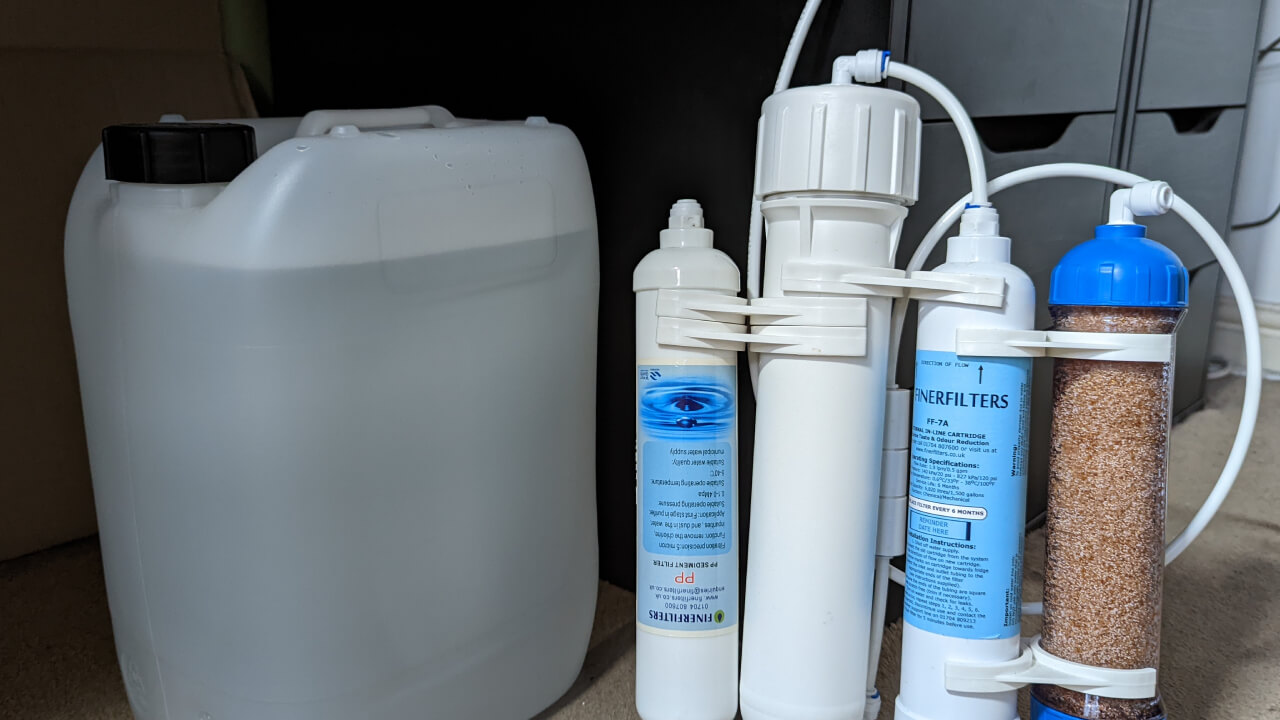Reverse Osmosis (RO) water can be very useful to have around for shrimp tanks.
You don’t need RO water, but it does have a few benefits over tap water.
The benefits of RO water for shrimp tanks
- Prevents TDS creep when topping up from evaporation
- Lets you remineralize your own water with ideal parameters
Topping up after evaporation
When water evaporates from your aquarium, the minerals in that water get left behind. This makes the remaining water slightly harder as more evaporates.
If you top up the tank with more remineralized water or tap water, you’ll keep pushing the TDS higher. The water hardness will climb up, and your shrimp can start getting stuck in their molts.
By topping up with RO water, you avoid this TDS creep entirely.
Once you reach the original water level again, it’s hardness and TDS will be the same as before. The minerals get diluted back to the earlier concentration.
Mix your own perfect water hardness
Using remineralizer salts, you can mix the perfect water for your shrimp.
With tap water, you have to hope your water company keeps the general hardness (GH) and carbonate hardness (KH) levels consistent.
When you make the water yourself, you’ve got complete control. You can mix the water parameters to exactly the GH and KH levels you’re after.
This is great for emergencies too. Knowing that you can quickly mix up a batch of water with identical parameters is reassuring.
You never know when you might need to do a sudden water change.
How to get RO water
Buy from your local fish store
Your local fish store will most likely offer reverse osmosis water.
You can either take in your own container to fill up, or buy a large canister full of RO water.
It might take a while to fill up though. You need a lot of pressure to filter large amounts of RO water quickly.
Unfortunately, some places don’t maintain their equipment as well as they should. You might find that your RO water actually had a TDS of 50, and they need to replace their filters.
If you can, take in a TDS pen and ask to test their RO water before you buy in bulk.
One other drawback is it can get quite expensive over time having to buy it.
Getting your own RODI system at home is definitely a good investment.
Buy a RODI filter system
Installing your own RODI filter at home will make your life much easier. Especially if you’ve got lots of shrimp tanks.
Over time, it’ll be cheaper and easier than having to run to your local fish store.
You’ll be able to replace the filters whenever you like, so you can give yourself the highest quality RODI water. It’s a good idea to replace the resin when you start seeing any TDS above zero.
You don’t need to install the filter directly into your plumbing. It’s definitely an option, but might be an appealing option for everyone.
Personally, I unscrew my shower head hose and have a connector that fits to my RODI filter.
This lets me quickly set up a temporary filter in the shower for a few hours, fill up a few 10L canisters, and then pack it all away.
RO vs RODI vs distilled water
RO water is what you get when you run tap water through a Reverse Osmosis filter.
It basically uses water pressure to squeeze the water through a few different types of filtration. Pretty much all of the impurities and minerals, like chlorine and calcium carbonate, get trapped and filtered out.
At the end of the RO system, you should be getting almost pure water. Anything up to 10 TDS is fairly common.
RODI
RODI is an extension of the RO system. The extra DI at the end means De-Ionized.
RODI water is the purest water you can get.
It’s usually done with a special resin in the last stage of the system.
Deionizing the RO water lets you get your TDS all the way down to zero. As soon as you start noticing your TDS getting to 1 or 2, it’s probably time to replace the resin.
If you have the option, I’d definitely recommend going with RODI.
Distilled
Distilled water is made in a different process. Instead of using filtration, water is boiled and then the condensation is collected again as purer water.
However, distillation can still leave some chemicals like chloramine in the output water.
RODI water will not have this risk, and that’s why it’s the most recommended type of water.
How does tap water compare?
- Tap water requires a dechlorinator
- Tap water has a risk of copper poisoning for your shrimp
Tap water usually includes chemicals, like chloramine, to make it safe to drink.
These chemicals are toxic for shrimp and snails, so you’ll need to use a dechlorinator or detoxifier to make it safe.
The RO filtering process takes out almost everything else from the water, so you don’t need to treat it with a dechlorinator.
There’s also some risk of copper poisoning from old plumbing in your home. Copper is incredibly harmful to shrimp, it can be lethal in tiny amounts.
As the RO filtration will take out any copper in the water, there’s no risk here.
Conclusion
You absolutely don’t need RO water to have healthy shrimp tanks, but it will give you a lot of flexibility.
You can mix your own water to specific parameters for stress free water changes.
If you have the budget, I’d definitely recommend getting a RODI filter.

